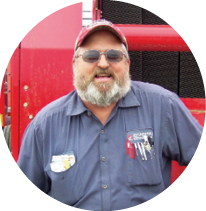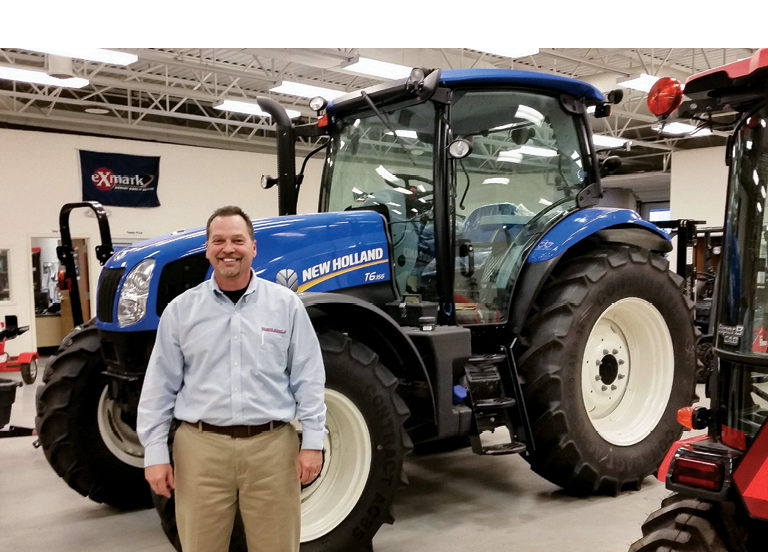Listen to audio version of this story:
Pictured Above: Kevin Crosen, sales manager for Winchester Equipment, which has locations in Virginia and Maryland, says used tractors in the 30-60 horsepower range are in the most demand. The dealership builds up its inventory of used construction equipment, such as skid steers, from its own rental department.
The rural equipment market, both new and used, is not showing signs of the downturn being experienced now for production agriculture dealers. For instance, values for used tractors in the 100 horsepower or less range have been trending up in recent years, compared with an overall downward trend for used farm equipment, according to Machinery Pete’s Fourth Quarter 2015 Used Values Index. (See the sidebar “Holding Steady”).
Values for other product categories in the used rural equipment market, including garden tractors, ATVs and skid steers, are ranking as strong or holding steady.
“Used equipment is very hot right now. New equipment prices are driven by Tier 4 mandates, which added a lot of expense. But it can sometimes be difficult to get used equipment because people are selling directly through social media,” says Kevin Crosen, sales manager for Winchester Equipment. The dealership has 5 locations in Virginia and one in Maryland and carries New Holland, Bobcat, Exmark, Stihl, Gravely, Simplicity, Woods Equipment and other lines.
Here’s how dealers make the most of a strong market, while laying the groundwork for future sales.
Building Inventory
Crosen says his dealership rarely says “no” when it comes to taking in used equipment on a trade. “We wouldn’t say no unless it was a shady deal. It has to be free of liens and we have to be sure the person who is selling it actually owns it. But even if we sell the equipment for recycling, it still has value,” he says.
Crosen and his team use a rating system to determine value. “Equipment that is ‘A’ quality has very low hours per the age of the tractor and the exterior is in pristine condition. ‘A’ quality equipment pushes the market value even higher than what could be expected. ‘B’ quality equipment is operable, the components are good, the transmission is good, but it might not look so good,” Crosen says. Equipment that falls below those levels would go directly to a wholesaler.

David Stevenson of Stevenson Tractor, Chesapeake, Va., says the market for used equipment is good in his area and demand is especially strong for tractors in the 25-50 horsepower range.
Often, his experienced sales staff is able to make the deal regarding the offer, but Crosen or road technicians do go on site if there is a question about value.
Seeking Models
In terms of used tractors, Crosen says that models in the 30-60 horsepower range are in the most demand. And, unlike new tractors, he says they are often sold alone as opposed to a package deal with attachments. “We don’t sell packages very often. Every once in a while we have used attachments that we can bundle,” Crosen says.
Dealer Takeaways
• Don’t jeopardize your reputation by selling used equipment that won’t hold up.
• Used rural equipment is in demand, but know your market area to set prices that bring you profit and move equipment off your lot.
• Develop a method that works for your team and your customers in terms of how you present new vs. used equipment during the sales discussion.
• Establish metrics for used vs. new inventory levels as well as timeframes for how long used equipment can stay on your lot.
He advises his sales team to let the customer steer the discussion between used vs. new. “I don’t think the sales rep dictates the discussion, but the customer does. Manufacturers definitely want us to promote new products and we’re not averse to selling new.
“We’ll communicate what’s available with 0% financing arrangements and how it compares to buying used equipment,” he says. “We’re programmed to sell equipment. We sell either used or new, whatever makes the customer happy.”
The dealership builds up its inventory of used construction equipment, such as skid steers, from its own rental department. He says his commercial customers generally buy new equipment, but those who need skid steers or mini excavators are willing at times to purchase good used equipment.
The dealership goes through a third party to offer warranties on used equipment, but warranties are generally only offered on units that are no more than 7 years old. And, regardless of age, they don’t warranty equipment such as forestry cutters, where liability related to maintenance and wear might be an issue.
Holding Steady

Greg Peterson, “Machinery Pete,” outlines steady to upward trends for sales of used rural equipment.
Machinery Pete’s Fourth Quarter 2015 Used Values Index shows that the used values index for all types of farm equipment was at 6.5, compared with 9.5 in 2008, which was the high mark since 2001. On the 1-10 rating scale, a 6.0 rating is considered historically normal/stable. A more positive trend is showing for used rural lifestyle equipment, however.
“The hobby farm market has picked up and, generally, the economy has picked up. Consumer confidence is going up as people are feeling more secure about their jobs,” says Greg Peterson, also known as Machinery Pete.
Peterson’s site www.MachineryPete.com, surveys 950 regional auctioneers, 600 ag lenders, 2,000 implement dealers and thousands of farmers in the U.S. and Canada. MachineryPete.com also features nearly 100,000 listings of used farm equipment from dealers nationwide.
Here’s how the used rural equipment market rated at the end of 2015:

Greg Peterson, also known as Machinery Pete, says stronger buyer demand continues for tractors 100 horsepower and under.
- 8.0 index for tractors 100 horsepower and under
- 7.2 index for garden tractors
- 7.8 index for ATVs
- 8.1 index for skid steers
Peterson is also able to gauge overall customer interest in equipment categories by analyzing searches on the site. Visitors can search by category (such as tractors, specialty crops, livestock equipment, hay and forage, etc.), subcategory, manufacturer and model.
He says in December, there was an 18% increase in searches for tractors under 40 horsepower and a 21% increase in searches for tractors 40-99 horsepower. That compares with a 17% increase for tractors 100-175 horsepower and 7% increase for tractors over 175 horsepower.

The strength of the economy, housing sector and employment rates indicate a strengthening for the garden tractor category.
“That tells you that there are more ‘eyeballs’ going to the smaller tractors,” Peterson says.
“This means sellers have the opportunity to do something different, but you need to shift from being a straight advertiser. You have to target customers,” Peterson says.
For instance, he recommends using targeted email campaigns based on zip codes or demographics and testing special pricing options only for those customer segments.
Dealers need to be aware that competition from auctions is increasing. The number of auctions in early December was up 37.3% from the previous year.
As a general guideline regarding used equipment prices at auctions, Peterson says that auction prices tend to run 74-76% of the value of the average dealer advertised price, providing dealers a benchmark for their own pricing strategies.
“Dealers need to be aware that there are more auctions happening. It’s not great for dealers, but great for buyers,” Peterson says.
Serving Customers
David Stevenson of Stevenson Tractor, Chesapeake, Va., says the market for used equipment is good in his area. “Our used equipment market has been holding steady for the last 24-36 months. Tractors in the 25-50 horsepower range are in demand for commercial and other end users,” he says. Stevenson Tractor carries New Holland, Kubota, Bush Hog, Land Pride and Echo.
He says his inventory of used commercial equipment has increased about 15% in the last year, due to a good housing market. About 25-30% of his used equipment inventory comes through the service department in instances where a customer chooses to buy new instead of proceeding with a repair.

Jeff Suchomski of Suchomski Equipment, Pinckneyville, Ill., says he’s having good success selling used attachments, specifically 3-point tillers, small (4x4) hay balers and 5- and 6-foot rotary cutters.
When taking in equipment on trade, Stevenson says he and the salesperson each come up with their price relying on their experience, by checking auction sites like Ritchie Brothers (www.RBAuction.com) and used equipment publications, like Fastline.
He says that about 75% of the time, he and the salesperson have this discussion in person to reach a price. For trades of good, in-demand equipment, they talk by phone while the salesperson is on site to keep the sales discussion moving forward with the customer.
A major factor they consider is whether they can offer a high level of support to the next buyer. “We stress our local support. Most customers come to us for knowledge and if I steer them wrong, they won’t come back to me again. A high percentage of our used customers, probably 70%, come back to buy a new tractor from us,” Stevenson says.
He says they like to sell used equipment to customers that live within about 60 miles of the dealership. “It doesn’t do us any good if we don’t see them again. These are the type of tractor buyers that you try to establish a relationship with,” Stevenson says.
Ranking Priorities
Stevenson says when considering used equipment, he’s found customers generally rank their concerns this way:
- Price
- Availability of financing
- Maintenance history
- What industry the equipment was used in
- Warranty
The dealership offers its own warranty for used New Holland or Kubota equipment that is less than 5 years old.

Demand is good among the rural lifestyle segment for used equipment. Dealers say there are ways to further increase revenues by setting guidelines about the equipment you’re willing to take in on trade and how long you’ll keep it in inventory.
“We’ve found that warranty is a big concern when customers are purchasing new, but doesn’t seem to be a big issue for those who are buying used equipment,” Stevenson says.
Selling New Ways
Stevenson says he limits the amount of used inventory he carries. “My used inventory is no more than 20% of my overall inventory. The number stays the same regardless of the economy,” he says.
He keeps the used inventory on the lot for about 90 days. The units are listed on the dealership’s website and customers can search the inventory by category of equipment, manufacturer, brand, price or model. If the unit isn’t sold in 90 days, he advertises it on Craigslist for 30 days. After 120 days, he sells to a wholesaler.
Stevenson sometimes partners with his customers by offering to sell their equipment through consignment. He says the approach has several benefits.
First, they can have inventory to display without investing in purchasing the equipment. Also, Stevenson says sometimes the customer has an unrealistic expectation for what the equipment is worth. This gives them a chance to test the market. “In most cases, we can then acquire the equipment for less when it doesn’t sell,” Stevenson says.
Carrying Attachments
Jeff Suchomski, owner of Suchomski Equipment, Pinckneyville, Ill., says his rural lifestyle sales are helping make up for shortfalls with the production market being down. His dealership carries Massey Ferguson, Cub Cadet, Woods Equipment and other lines.
For used equipment, he’s having good success with tractor attachment sales, specifically with such equipment as 3-point tillers, small (4x4) hay balers and 5- and 6-foot rotary cutters.
“Appearance means a lot when it comes to small equipment. If it’s nice and shiny and looks good, it’s going to sell,” Suchomski says.
He says it can be difficult to find smaller used attachments. He mainly builds their inventory through trade-ins. For instance, a customer might purchase a 25 horsepower tractor and attachments for his first purchase and then later want to trade up to a higher horsepower tractor and may need different attachments.
He stays away from purchasing through auctions. “I grew up in the business. I remember years ago when neighboring dealers would go to auctions to buy equipment and it would just make customers who were also bidding on the equipment mad,” Suchomski says.
“A high percentage of our used customers come back to buy new...”
Within 60 miles of his dealership, Suchomski competes with 9 John Deere dealerships, 7 New Holland dealerships and 12 Kubota dealerships. For this reason, he says he’s realistic about setting a price that moves inventory, but is careful to guard his reputation as a trusted dealer.
“I started in our dealership as a technician, so if I know something is not going to hold up, I won’t sell it,” he says.
He doesn’t mind taking in used Tractor Supply Co. (TSC) attachments as long as they are in good working order and have a good appearance.
“If it’s a name brand, it sells better. TSC blades might go for $200, but a Woods, Rhino or Bush Hog blade could sell for $600,” he says.
Suchomski also doesn’t shy away from taking in specialty attachments, such as small planters and seeders as hunters seek them out for food plots for hunting.
Sales on used equipment often are driven by word of mouth referrals as well as his weekly listings in TractorHouse’s print issue. The listing takes considerable effort, including supplying photos and information that might change weekly.
“It’s very expensive advertising. I went to a half page ad in the book and I pay $395 a week, but you do get phone calls from it.” He also uses TractorHouse to help set the market value on used equipment.
Used equipment sales opportunities are an opportunity to build relationships — and support future purchases of new equipment.
“I always offer used equipment first and then offer new as the upsell. A lot of times, though, the condition drives the sale. If it’s used and beat up, that’s not going to work for the guy who is competing with his neighbor on equipment,” Suchomski says.






Post a comment
Report Abusive Comment